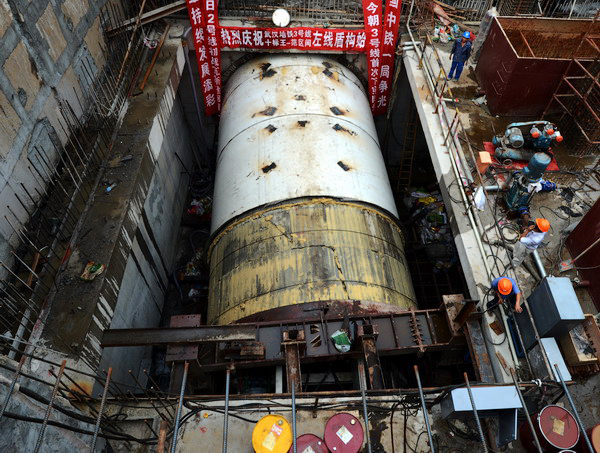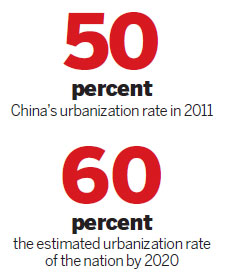Urbanization is backbone of the booming economy
Updated: 2013-01-17 15:16
By Huang Ying (China Daily)
|
||||||||
Urban rail development, and medical and other services are likely to lead the Chinese economy in 2013, which is almost certain to be a year of greater growth than 2012 was.
They reflect the stronger-than-ever momentum in the drive for urbanization, and the government's intention to use it as the economy's main powerhouse in the coming decades.
All industries that have something to do with the development of cities and city-based services are poised to grow faster.
|
 A boring machine begins to tunnel at a construction site for subway Line 3 in Wuhan, capital of Hubei province, on Sept 11. As the city's first subway line linking Hankou and Hanyang, two key areas of the city, the first stage project of the line is expected to open to traffic in 2015. [Photo / China Daily] |
So are the companies in these industries - so long as they deliver quality goods and services and stay away from corruption and regulatory offenses.
Urbanization has been a main factor driving the Chinese stock market, as read by the Shanghai Composite Index, to rise more than 18 percent from early December to Wednesday.
In a number of government conferences, Vice-Premier Li Keqiang said he pins high hopes on the potential of urbanization in China.
|
 |
Many economists argue that urbanization will be the theme of China's change in its business and social horizon over the next decade and beyond, instead of the export-oriented industry, which no longer suffices to generate new growth due to the sluggish global market demand in the post-recession era.
In 2011, the urbanization rate, the proportion of the people living in cities, just passed 50 percent. By 2020, the government aims to have this figure at 60 percent.
In comparison, developed economies in Europe and the United States have an urbanization rate of about 80 percent.
According to a research report by BOC International (China) Ltd, the railway industry will see many new opportunities in the development of high-speed and intercity train services.
Analysts predict the demand for railway construction will occur in the eastern part of the country before it does in the western and central regions.
Demand for transportation facilities will first emerge in first-tier cities, as they have stronger economies and are capable of launching large-scale infrastructure projects, according to CEBM Group Ltd, an independent investment advisory firm.
Grain supply concern amid fast urbanization: report
Shopping malls boom in China on urbanization
China vows to accelerate urban renovation

 Li Na on Time cover, makes influential 100 list
Li Na on Time cover, makes influential 100 list
 FBI releases photos of 2 Boston bombings suspects
FBI releases photos of 2 Boston bombings suspects
 World's wackiest hairstyles
World's wackiest hairstyles
 Sandstorms strike Northwest China
Sandstorms strike Northwest China
 Never-seen photos of Madonna on display
Never-seen photos of Madonna on display
 H7N9 outbreak linked to waterfowl migration
H7N9 outbreak linked to waterfowl migration
 Dozens feared dead in Texas plant blast
Dozens feared dead in Texas plant blast
 Venezuelan court rules out manual votes counting
Venezuelan court rules out manual votes counting
Most Viewed
Editor's Picks

|

|

|

|

|

|
Today's Top News
Boston bombing suspect reported cornered on boat
7.0-magnitude quake hits Sichuan
Cross-talk artist helps to spread the word
'Green' awareness levels drop in Beijing
Palace Museum spruces up
First couple on Time's list of most influential
H7N9 flu transmission studied
Trading channels 'need to broaden'
US Weekly

|

|








